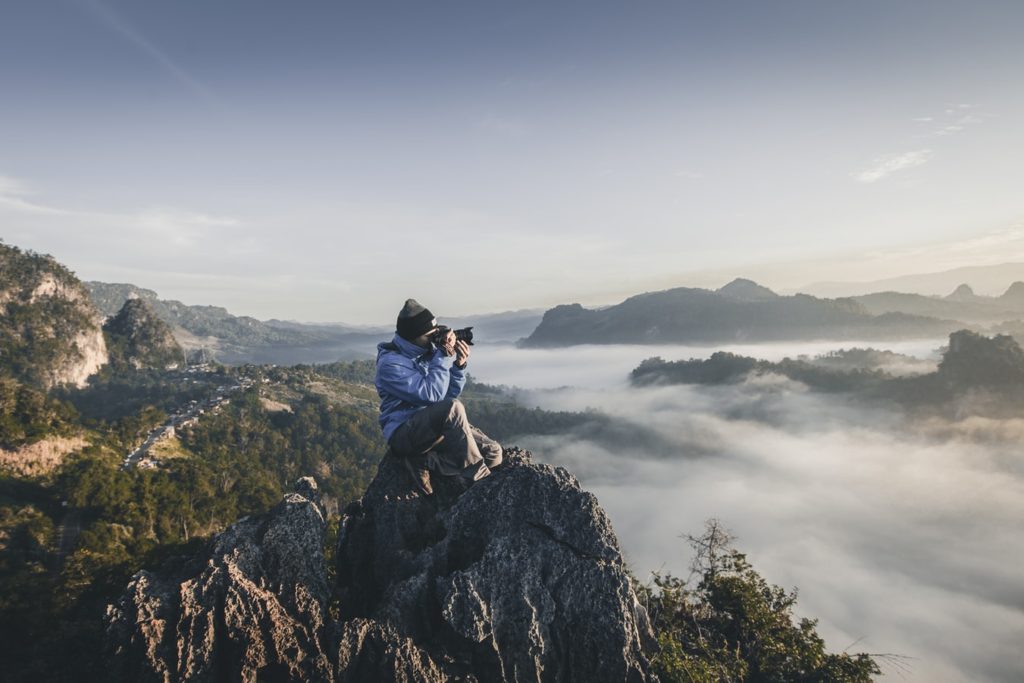If you love communing with nature and don’t feel fully dressed unless a camera is slung over your neck, a career in landscape photography might be tremendously satisfying. It can also be quite rewarding, financially.

Landscape photographers use their artistic skills to capture beautiful images of the natural world. Mountains and valleys. Wildflower meadows and waterfalls. Canyons, deserts, Antarctic ice sheets. All offer a breathtaking reminder of the world’s beauty. And the sights you capture with your camera are free for the taking. You need to pay a supermodel to take her picture. You don’t need permission from the Grand Canyon.
Your clients will skew toward more affluent individuals who want gorgeous prints of landscape photography to decorate their homes and offices. Property owners, such as a company that manages a ski resort, need landscape photographs to show off their assets to maximum advantage, helping them attract new customers. You’ll also find eager clients at outdoor-themed magazines, both printed and online.
Some landscape photographers load their images to a stock photo website where consumers buy and download the pictures they like. In this way, a photographer can sell the same image over and over, reaping all the profits that demand for the image can create.
You’ll also enjoy tremendous flexibility in working when and wherever you wish.
Read on to discover what it takes to become a landscape photographer.
In this article you’ll learn:
- How much money you can make as a landscape photographer
- The required training and certifications
- Professional groups to join
- Employment opportunities for landscape photographers
- Finding clients
- Plus helpful tips
How much money can you make?
The annual salary of landscape photographers working in the United States ranges from $10,714 to $288,163. The average is $51,931 per year, according to a recent survey by Comparably. About 86% of these photographers make more than $288,000 a year. Landscape photographers are usually self-employed, set their own schedules and work when they want.

There are 3 main ways to earn money with landscape photography::
- Sell images as stock shots through online websites such as Alamy or Getty. You can also contact magazines and newspapers directly with your offer. Websites will take a portion of your earnings as a commission for using their platforms to promote your work.
- Make prints from your landscape images to sell to customers for décor in their homes and offices.
- Accept a commission from a client for a specific assignment. For example, a property owner might want attractive images to use with a real estate advertisement for selling the land, or the management of a golf course might want some fresh images of the facilities and course to attract new members to the club.
Training and Certification
Landscape photography is not licensed or regulated at the state level in the United States. There is a chance some regulations are in place at the city or county level. A quick call to your local government will confirm one way or another if there are any regulations governing photographers in your area. Chances are, there will be none.
It can still be extremely helpful to train specifically for work in landscape photography. This can save you a lot of time by learning common mistakes to avoid that you might otherwise make through trial and error on the job. The difference is knowing mistakes to avoid in advance means you deliver images to the client faster and offer better customer service.

Many training programs are available online to help you learn the basics of landscape photography. Most are highly affordable. You can buy an online class to complete at your own pace for under $100. Courses that come with textbooks and instructional DVDs sell for around $300. It pays to shop around online to find the right training materials for you, based on your experience level with photography. No reason to buy more training than you need.
Here are some popular landscape photography courses:
Landscape Photography with Marc Muench
Professional outdoor photographer Marc Muench teaches the skills to create incredible landscape images.
The Outdoor Photography Experience Course with Chris Burkard
Pro photographer Chris Burkard shares his unique style and techniques in a course that also covers gear, camera setup and process, and post-production/digital editing.
Photographing America’s National Parks
Professional outdoor photographer Ian Shive guides you through scenic locations in America’s national parks, demonstrating how to capture images that are aesthetically appealing by using the right camera settings and techniques.
Night Photography Week – 5 Days of Tips and Techniques for Epic Night Photos
Expand your repertoire by learning how to take stunning nighttime images. Learn how to photograph the Milky Way in the night sky, capture star trails with long exposures and how to use your camera to paint with light.
Landscape Photography: Start to Finish with Matt Kloskowski
In this beginner course pro photographer Matt Kloskowski shows you how to take amazing landscape photos. The course covers gear, developing an eye for great compositions, using the correct camera settings and the basics of post-processing your images in Photoshop or another digital-imaging tool.
Photoshop and Lightroom for Landscape Photographers Course
Photoshop is the #1 software tool for editing digital images. This course walks you through the basics of the software and the tools you’ll use most often when editing your landscape photos. Because Photoshop is an immensely powerful software package with a fairly steep learning curve, it can be helpful to take a course that covers the core features you need to know right away, helping you save time during post-production.

Professional Groups to Join
The International Landscape Photographers Association is a group of landscape photographers wanting to learn from each other, share with each other, and grow professionally. Members who join at the professional level receive their own web page with links to their portfolio – a useful tool in attracting clients. Visit the association’s website for current pricing details.
The North American Nature Photography Association offers networking with other professionals, continuing education, exclusive events and seminars, and more. Annual membership is $100.
Professional Photographers of America is the premiere organization of photography pros in the United States. A full membership is open to anyone living in the United States or its territories and costs $323 per year. Benefits include:
- $15,000 equipment insurance policy
- Data loss protection
- Access to all online education courses
- Online referral database listing
- Printed and digital monthly issues of Professional Photographer magazine
- One full registration to Imaging USA during the first year of membership
- Business Resources
- Contracts and Copyright Resources
- Access to Member Discount Program
- Weekly newsletter
Employment
Contact resorts, ski lodges, camping facilities and other venues targeting outdoor enthusiasts. Send them your marketing materials, brochures and business cards. Follow up with a phone call in a day or two. If your contact says she’s already working with a photographer, ask if she knows anyone who needs your services. Don’t be discouraged by rejection when calling potential clients. The very next call you make could be gold.
Use the networking power of your professional memberships to find assignments.
Finding Clients
Business cards and a basic website should be the core of your marketing toolkit. The website need not be fancy or expensive, just attractively designed, with photos of your best landscape photography work, your business location and contact information. No need to include your pricing. You can discuss that directly with clients. Posting prices online is a slippery slope. Before you know it, you’re updating your website every other day to keep pace with the competition. It can turn out to be a fast race to the bottom.

In addition to your business website, create an Instagram account to showcase your landscape photography services. Instagram is the #1 online venue for creative professionals to display their work.
Other strategies for attracting new business:
- Create a referral program with discounts for returning customers who bring new clients to you.
- Ask clients to review your services online. According to a recent survey, 90% of people say their buying decisions are influenced by positive online reviews.
Good to know
Beginners starting out in landscape photography will usually want to learn all they can, and that includes thumbing through the many photography magazines available at bookstores, newsstands and online. In those publications you’ll encounter page after page of advertising for cameras, equipment and accessories. Much of it, particularly lenses, will be extremely expensive.
You don’t need a footlocker full of camera equipment to start working as a landscape photographer. In fact, building up your equipment kit gradually makes the most sense because you’ll only be buying what you need when you realize you need it. So resist the temptation to purchase every gadget on the market.

Here’s what landscape photographers need for their basic kit:
- DSLR (digital single-lens reflex) camera
- A quality lens with a focal length of 24-70mm
- A sturdy and dependable tripod with a carrying case and strap to sling it over your shoulder
- Graduated neutral density filters
- A polarizing filter
- A water-proof (or at minimum water-resistant) camera bag with shoulder strap to haul everything.
Over time, you can add more lenses when you feel you need them to expand your creative options. A remote shutter release is also a handy piece of gear when working with a tripod. Some attach directly to the camera. Many modern cameras now feature a shutter-release app that you can download to your smartphone. The phone connects wirelessly to the camera via Bluetooth and you simply press the button on the phone screen to capture an image. Some of these apps also allow you to download images from the camera directly to your phone so you can quickly share them with clients and friends by attaching pictures to text messages or emails.
If you enjoyed this article, check out some more great PocketSuite.io content that can help you grow your career as a landscape photographer. Here’s a great place to start.PocketSuite has thousands of business owners who all started where you are right now. Our community is always happy to help you ramp up, grow your client base, and achieve your income goals, both within the PocketSuite app and as part of our exclusive Facebook Community Group. PocketSuite’s vision is for any professional to be able to work for themselves and make a great living. It starts here. It starts with you. It starts today. Let’s get started, download PocketSuite now! Feel free to reach out with any questions (we’d love to hear from you)! Text us @ (415) 841-2300.



